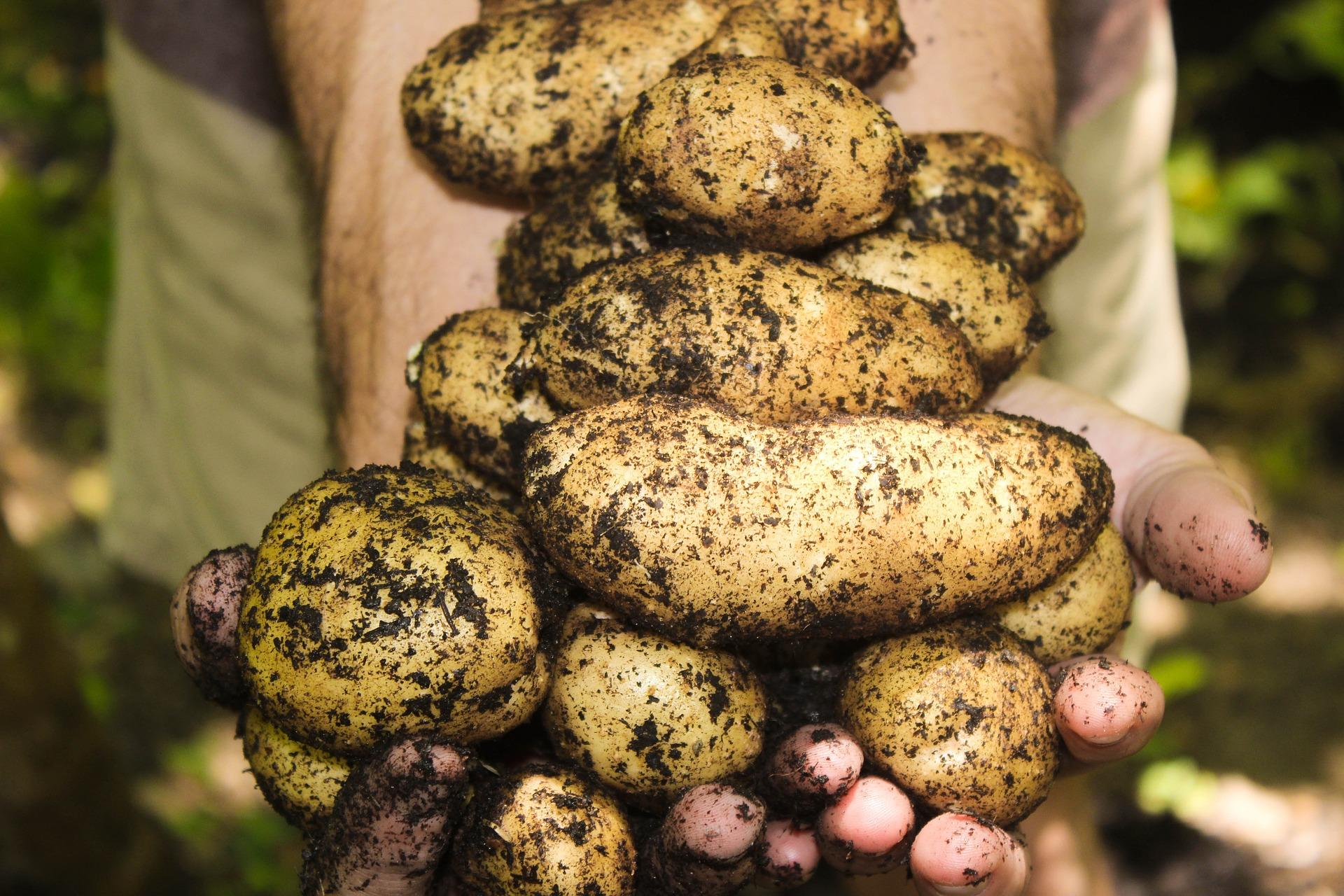Planting potato facts
- Hardiness: Half-hardy annual. They can withstand light frosts, but not heavy frosts or freezing.
- Planting: Plant 1½ to 2 oz. seed pieces (1½-inch cubes) with 1 to 3 buds (“eyes”) or small, whole seed potatoes, from March 15 to May 1 depending on your location; will resist light frost. The soil temperature should be at least 45 degrees F. A 6-ounce potato can be cut into four seed pieces, each with at least one good bud or eye. Let pieces dry for a few days before planting to help avoid rot. You can also help prevent disease and insect injury by coating the seed pieces with elemental sulfur (place seed pieces and the sulfur in a bag and shake).
Or, try “green sprouting” for an even earlier start. Keep whole tubers in the dark at room temperature until they sprout. Then expose tubers to light to keep sprouts short. Cut into seed pieces and plant. Seed potatoes of early-maturing varieties can also be planted through June 1 for an extended harvest. Purchase certified disease-free seed potatoes from a reputable company. Seed potatoes should be firm and un-sprouted. Wilted and sprouted potatoes have reduced vigor. Last season’s garden tubers and store-bought potatoes may be symptomless disease carriers and should be avoided. Full sun requires direct light at least 6 hours/day; prefers 8 - 10 hours/day. - Days to maturity: 90 - 120.
- Spacing: 8" - 12" in-rows x 24" - 36" between row. If you would like to mainly harvest new potatoes, space plants 9” apart. If large storage potatoes are your goal space plants as far as 20” apart. Plant potatoes in furrows cut side down, 3- to 5-inches deep. Later crops should be planted 5- to 6-inches deep.
- Fertilizer needs: Refer to Fertilizing Vegetables for details.
- Approximate yield: 6 to 15 lbs. per 10-foot row.
Potato problems
Colorado potato beetle
Common scab
Potato leafhopper
Potato tuberworm
Growing and care of potatoes
- The potato, Solanum tuberosum, probably originated in the Peruvian highlands over 6,000 years ago.
- Potatoes grow best in well-drained soil high in organic matter with a pH of 6.0 to 6.5. Where potato scab disease is a persistent problem, a soil pH of 4.8 to 5.8 is recommended.
- The potato plant remains upright and tender through the growing season and may reach 3 ft. in height. Tubers are enlarged, modified stems (not roots) that develop at the ends of underground stems (stolons). Tubers develop close to the original seed piece that was planted. Potatoes can be successfully grown in containers but potato "towers" don't usually work.
- There are many cultivars with different coloration, inside and out. Potato plants produce flowers and sometimes small potato-like fruits with seeds inside. However, the seed is extremely small and, if planted, will not come true to the desired variety.
- Potatoes can be grown as an early crop for new potatoes and as a late crop for storage. Choose an early-maturing variety and a medium- to late-maturing variety for a more continuous harvest.
- Plant potatoes from March 15 to May 1, depending on your location. Potatoes grow rapidly with cool spring weather but hard frosts will retard growth and seed pieces will languish or rot if planted during prolonged cold weather.
- Purchase certified seed stock. Supermarket potatoes can be infected with diseases without exhibiting any symptoms. Saving your own seed potatoes is generally not worthwhile because viruses and diseases often show up the next year. Seed potatoes should be firm and un-sprouted. Plant seed pieces in furrows cut side down, 3- to 5-inches deep. Late crops should be planted 5- to 6-inches deep.
- When the tops are fully grown, hill up soil over potatoes around the base of each plant to shield tubers from the sun, which can cause greening or scalding. The tops of the hills should not be more than 6-in. above grade.
- Soil temperature in excess of 80°F will inhibit tuber development.
- Watering - Keep plants well-watered if rainfall is lacking, especially while tubers are developing. Avoid overhead watering as it can spread fungal diseases. Too much or too little water is associated with many tuber disorders, including blackheart, cracks, and misshapen tubers.
- Weeding - Hand-pull weeds. Any cultivation with a hoe or other tool should be shallow and far enough from the plants to prevent damage. Apply a thick straw mulch, after hilling up the soil, to keep the soil cool and moist and to deter Colorado potato beetles.
Harvesting potatoes
- Small, tender “new” potatoes can be harvested 6 to 8 weeks after planting, usually once the plants have flowered.
- Gently dig the soil around the young potatoes with a garden fork to avoid damaging the plant and bruising or spearing tubers. Bruises and cuts sustained during the harvest will allow entry of soil-borne fungi and bacteria that cause storage rots. Also, avoid long exposure to light.
- Tubers will continue to grow through the summer until plants are killed by frost, mowing, or insects and diseases.
- If you plan to store potatoes, leave tubers in the ground for 2 weeks after plants die back. This will allow them to develop a thickened skin.
- Don't dig potatoes if the soil is wet. Gently knock off attached soil when harvesting but don't wash tubers prior to storage.
Storing potatoes
- Storage potatoes are cured for 10 to 14 days at 50°F to 60°F and high humidity to heal over wounds and cuts.
- Medium cool (40°- 50°F), moist (90% RH) conditions; 6 to 8 months. Store tubers in a cool basement in ventilated bags or boxes out of the light to prevent greening. Green portions (chlorophyll) on potatoes are associated with solanine, a bitter, toxic glycoalkaloid. They should be cut out and discarded.
- Sprouting and tuber rots are a problem at higher temperatures.
